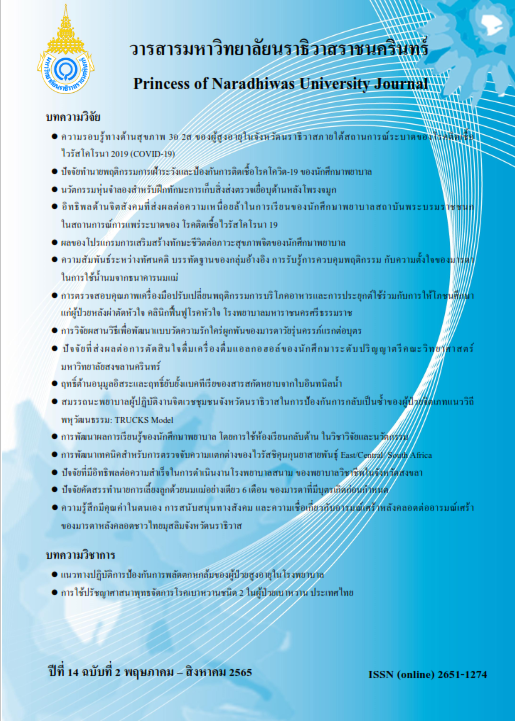แนวทางปฏิบัติการป้องกันการพลัดตกหกล้มของผู้ป่วยสูงอายุในโรงพยาบาล
คำสำคัญ:
แนวทางปฏิบัติ, การป้องกันพลัดตกหกล้ม, ผู้ป่วยสูงอายุ, โรงพยาบาลบทคัดย่อ
การพลัดตกหกล้มเป็นปัญหาสาธารณสุขที่สำคัญ เป็นสาเหตุของการเสียชีวิตอันดับสองรองจากการบาดเจ็บจากอุบัติเหตุทางถนน ซึ่งปัญหาการพลัดตกหกล้มของผู้สูงอายุในโรงพยาบาลพบว่าเกิดจากปัจจัยภายในบุคคลเป็นสำคัญ โดยเฉพาะในผู้ป่วยสูงอายุพบว่ามีปัจจัยเสี่ยงที่ทำให้เกิดการพลัดตกหกล้ม มีอยู่ 2 ประเภท ได้แก่ ปัจจัยภายในบุคคลและปัจจัยภายนอกบุคคล ซึ่งปัจจัยภายในบุคคลมีด้านร่างกายและด้านจิตใจ โดยการศึกษาวิจัยพบว่าเพศหญิงมีโอกาสเกิดการพลัดตกหกล้มได้มากกว่าเพศชาย เนื่องจากเพศหญิงมีความแข็งแรงของกล้ามเนื้อน้อยกว่าเพศชาย ทำให้มีการทรงตัวไม่สมดุล ส่วนปัจจัยภายนอกบุคคล พบว่าปัจจัยเสี่ยงสำคัญ คือผู้สูงอายุมีอาการเจ็บป่วยร่วมกันหลายโรค ทำให้ได้รับยาหลายชนิด อาจทำให้เกิดปฏิกิริยาต่อกัน ซึ่งอาจมีผลข้างเคียงต่าง ๆ ต่อระบบประสาทและระบบหัวใจและหลอดเลือด ทำให้เกิดผลข้างเคียงของยาได้ ทำให้ผู้สูงอายุมีความเสี่ยงต่อการพลัดตกหกล้มมากขึ้น และแนวทางปฏิบัติการป้องกันการพลัดตกหกล้มของผู้ป่วยสูงอายุในโรงพยาบาลปัจจุบันพบว่ามีแนวทางการปฏิบัติที่ไม่ชัดเจน และไม่สะดวกต่อการใช้ประเมินในกลุ่มผู้ป่วยสูงอายุ ดังนั้นการดูแลและเฝ้าระวังผู้ป่วยสูงอายุในโรงพยาบาลเป็นสิ่งที่สำคัญ เพื่อให้ผู้ป่วยเกิดความปลอดภัย ลดการสูญเสียของตัวผู้ป่วย ครอบครัว และเศรษฐกิจโดยรวม บทความนี้มีวัตถุประสงค์ คือนำเสนอเกี่ยวกับแนวทางปฏิบัติการป้องกันการพลัดตกหกล้มของผู้ป่วยสูงอายุในโรงพยาบาลที่ได้พัฒนาขึ้นให้มีความสะดวกต่อการใช้และเหมาะสมกับบริบทหอผู้ป่วยในโรงพยาบาลมากขึ้น และจะเป็นแนวทางในการดูแลผู้ป่วยสูงอายุ เพื่อให้เกิดผลลัพธ์ที่ดี มีคุณภาพความปลอดภัยในการรับบริการของผู้ป่วยสูงอายุเป็นสำคัญ และนำมาซึ่งความเป็นเลิศทางการพยาบาล ถือว่าเป็นหัวใจสำคัญของการให้บริการในยุคไทยแลนด์ 4.0 ปัจจุบัน
เอกสารอ้างอิง
Alamgir, H., Muazzam, S., & Nasrullah, M. (2012). Unintentional falls mortality among elderly in the United States: time for action. Injury, 43(12), 2065-2071.
American Geriatrics Society/British Geriatrics Society. (2010). Summary of the Updated American Geriatrics Society/British Geriatrics Society Clinical Practice Guideline for Prevention of Falls in Older Persons. Journal of the American Geriatrics Society, 59(1), 148-157.
Assantachai, P. (2015). Health and prevention of falls and complications in the elderly by a geriatric physician. Bangkok: Office of the National Research Council of Thailand. (in Thai)
Bakr. I.M., Abd Elaziz, K.M., Elgaafary, M.M., Kandil, S,K., & Fahim, H.I., (2011). Epidemiologic pattern of falls among inpatients in Ain Shams University Hospital in Cairo, Egypt. Journal of Preventive Medicine and Hygiene, 52(1), 32-37.
Bureau of Epidemiology, Department of Disease Control, Ministry of Public Health. (2015). Control of NCDs. Retrieved May 21, 2010 from http://203.157.15.4/Annual/ANNUAL2550 /Part1/ 6650_Chronic.doc.
Bureau of NCDs, Department of Disease Control, Ministry of Public Health. (2020). Annual Report 2017. Retrieved June 4, 2019. from http://www.thaincd.com/2016/media-detail.php?id= 12986&tid=30&gid=1-015-008.
Chung, H., & Coralic, A. (2016). A multidisciplinary assessment instrument to predict fall risk in hospitalized patients: A prospective matched pair care study. Journal of Nursing Education and Practice, 6(6).
Cohen, L., & Guin, P. (1991). Implementation of a patient fall prevention program. Journal of Neuroscience Nursing, 23(5), 315-319.
George, A.K. & Catherine, E.D. (2009). Urinary Incontinence in the Elderly. American Society of Nephrology, 1-4.
Hendrich, A.L. Bender, P.S. & Nyhuis, A. (2003). Validation of the Hendrich II Fall Risk Model: A large concurrent case/control study of hospitalized patients. Applied Nursing Research. 16(1), 921.
Hignett, S., Sands, G., Youde, J., & Griffiths, P. (2010). Targeting environmental factors to reduce elderly in-patient falls. Loughborough University. Retrieved March 10, 2016 from http:// dspace.Iboro.ac.uk/dspace.
Hospital Accreditation Institute. (2021). Patient and Personnel Safety for Emerging Infectious Diseases. Retrieved March 10, 2016 from https://www.si.mahidol.ac.th/th/division/rm/admin/ download_files/66_40_1JEr PEt.pdf.
Legters, K. (2002). Fear of Falling. Physical Therapy, 82(3), 264-272
Morse, J.M. (1997). Preventing Patient Falls. Thousand Oaks, CA: Sage Publications. National Database of Nursing Quality Indicators. (2013). Changes to NDNQI fall indicator Coming for 2Q 2013. NDNQI Nursing Quality News, 14(1), 2.
Ngamkala, T., Inthasombat, I., & Munkong, S. (2011). Knowledge synthesis. Concerning the revention and management of falls in hospitalized patients. Ramathibodi Hospital, 17(1), 107-124.
Perell, K.L., Nelson, A., Goldman, R.L., Luther, S.L., Prieto-Lewis, N., & Rubenstein, L.Z. (2001). Fall Risk Assessment Measures: An analytic Review. The Journals of Gerontology: Series A, 56(12), 761-766.
Raksri, M. (2019). Effects of Health Belief Adjustment Program on Spill Prevention Behaviors. Fall of an elderly patient in the hospital. Bangkok: Mahidol University. (in Thai)
Scott,V., Votova, K., Scanlan, A., & Close, J. (2007). Multifactorial and functional mobility assessment tools for fall risk among older adults in community, home-support, long-term and acute care settings. Age Ageing, 36(2), 130-139.
Srichang, N., & Kawee, L. (2017). Fall forecast report for the elderly (age 60 years and older) In Thailand, 2017-2021, Bureau of Non-communicable Diseases, Department of Disease Control, Ministry of Public Health. Bangkok: Printing Affairs Office, The War Veterans Organization of Thailand. (in Thai)
World Health Organization. (2021). Violence and Injury Prevention: Falls. Retrieved June 4, 2019 from http://www.who.int/violence_injury_prevention/other_injury/falls/en/
ดาวน์โหลด
เผยแพร่แล้ว
รูปแบบการอ้างอิง
ฉบับ
ประเภทบทความ
สัญญาอนุญาต
ลิขสิทธิ์ (c) 2022 วารสารมหาวิทยาลัยนราธิวาสราชนครินทร์

อนุญาตภายใต้เงื่อนไข Creative Commons Attribution-NonCommercial-NoDerivatives 4.0 International License.




